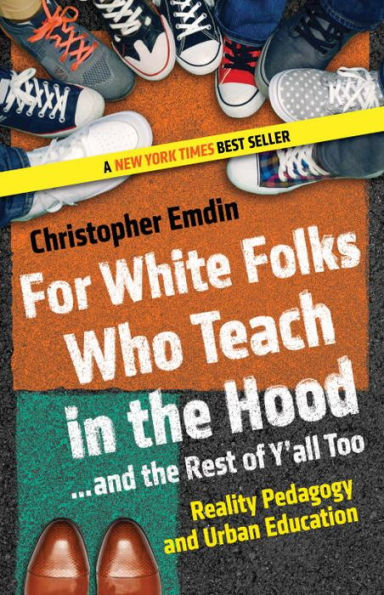A New York Times Best Seller
Merging real stories with theory, research, and practice, a prominent scholar offers a new approach to teaching and learning for every stakeholder in urban education.
Drawing on his own experience of feeling undervalued and invisible in classrooms as a young man of color and merging his experiences with more than a decade of teaching and researching in urban America, award-winning educator Christopher Emdin offers a new lens on an approach to teaching and learning in urban schools. For White Folks Who Teach in the Hood...and the Rest of Y’all Too is the much-needed antidote to traditional top-down pedagogy and promises to radically reframe the landscape of urban education for the better.
He begins by taking to task the perception of urban youth of color as unteachable, and he challenges educators to embrace and respect each student’s culture and to reimagine the classroom as a site where roles are reversed and students become the experts in their own learning.
Putting forth his theory of Reality Pedagogy, Emdin provides practical tools to unleash the brilliance and eagerness of youth and educators alike—both of whom have been typecast and stymied by outdated modes of thinking about urban education. With this fresh and engaging new pedagogical vision, Emdin demonstrates the importance of creating a family structure and building communities within the classroom, using culturally relevant strategies like hip-hop music and call-and-response, and connecting the experiences of urban youth to indigenous populations globally. Merging real stories with theory, research, and practice, Emdin demonstrates how by implementing the “Seven C’s” of reality pedagogy in their own classrooms, urban youth of color benefit from truly transformative education.
For White Folks Who Teach in the Hood...and the Rest of Y'all Too has been featured in MotherJones.com, Education Week, Weekend All Things Considered with Michel Martin, Diverse: Issues in Higher Education, PBS NewsHour.com, Slate, The Washington Post, Scholastic Administrator Magazine, Essence Magazine, Salon, ColorLines, Ebony.com, Huffington Post Education
A New York Times Best Seller
Merging real stories with theory, research, and practice, a prominent scholar offers a new approach to teaching and learning for every stakeholder in urban education.
Drawing on his own experience of feeling undervalued and invisible in classrooms as a young man of color and merging his experiences with more than a decade of teaching and researching in urban America, award-winning educator Christopher Emdin offers a new lens on an approach to teaching and learning in urban schools. For White Folks Who Teach in the Hood...and the Rest of Y’all Too is the much-needed antidote to traditional top-down pedagogy and promises to radically reframe the landscape of urban education for the better.
He begins by taking to task the perception of urban youth of color as unteachable, and he challenges educators to embrace and respect each student’s culture and to reimagine the classroom as a site where roles are reversed and students become the experts in their own learning.
Putting forth his theory of Reality Pedagogy, Emdin provides practical tools to unleash the brilliance and eagerness of youth and educators alike—both of whom have been typecast and stymied by outdated modes of thinking about urban education. With this fresh and engaging new pedagogical vision, Emdin demonstrates the importance of creating a family structure and building communities within the classroom, using culturally relevant strategies like hip-hop music and call-and-response, and connecting the experiences of urban youth to indigenous populations globally. Merging real stories with theory, research, and practice, Emdin demonstrates how by implementing the “Seven C’s” of reality pedagogy in their own classrooms, urban youth of color benefit from truly transformative education.
For White Folks Who Teach in the Hood...and the Rest of Y'all Too has been featured in MotherJones.com, Education Week, Weekend All Things Considered with Michel Martin, Diverse: Issues in Higher Education, PBS NewsHour.com, Slate, The Washington Post, Scholastic Administrator Magazine, Essence Magazine, Salon, ColorLines, Ebony.com, Huffington Post Education

For White Folks Who Teach in the Hood... and the Rest of Y'all Too: Reality Pedagogy and Urban Education
232
For White Folks Who Teach in the Hood... and the Rest of Y'all Too: Reality Pedagogy and Urban Education
232
Product Details
| ISBN-13: | 9780807028025 |
|---|---|
| Publisher: | Beacon |
| Publication date: | 01/03/2017 |
| Series: | Race, Education, and Democracy |
| Pages: | 232 |
| Sales rank: | 6,573 |
| Product dimensions: | 5.40(w) x 8.40(h) x 0.70(d) |
About the Author
Customer Reviews
Explore More Items
Now in graphic novel format, Lois Lowry’s Newbery Medal–winning classic story of a young boy
Trouble is brewing in Village. Once a utopian community that prided itself on
Left orphaned and physically flawed in a civilization that shuns and discards the
Two generations of the Carter family coming of
Inspired by her blockbuster phenomenon Wonder, R. J. Palacio makes her graphic novel debut with an
Más de 6 millones de personas se han enamorado de La lección de August, el libro que inspiró el movimiento ELIGE SER AMABLE. Ahora la historia de Auggie está en la
A National Book Award Finalist for Young People’s Literature
Nominated as one of America’s best-loved novels by PBS’s The Great American Read
Ghost wants
